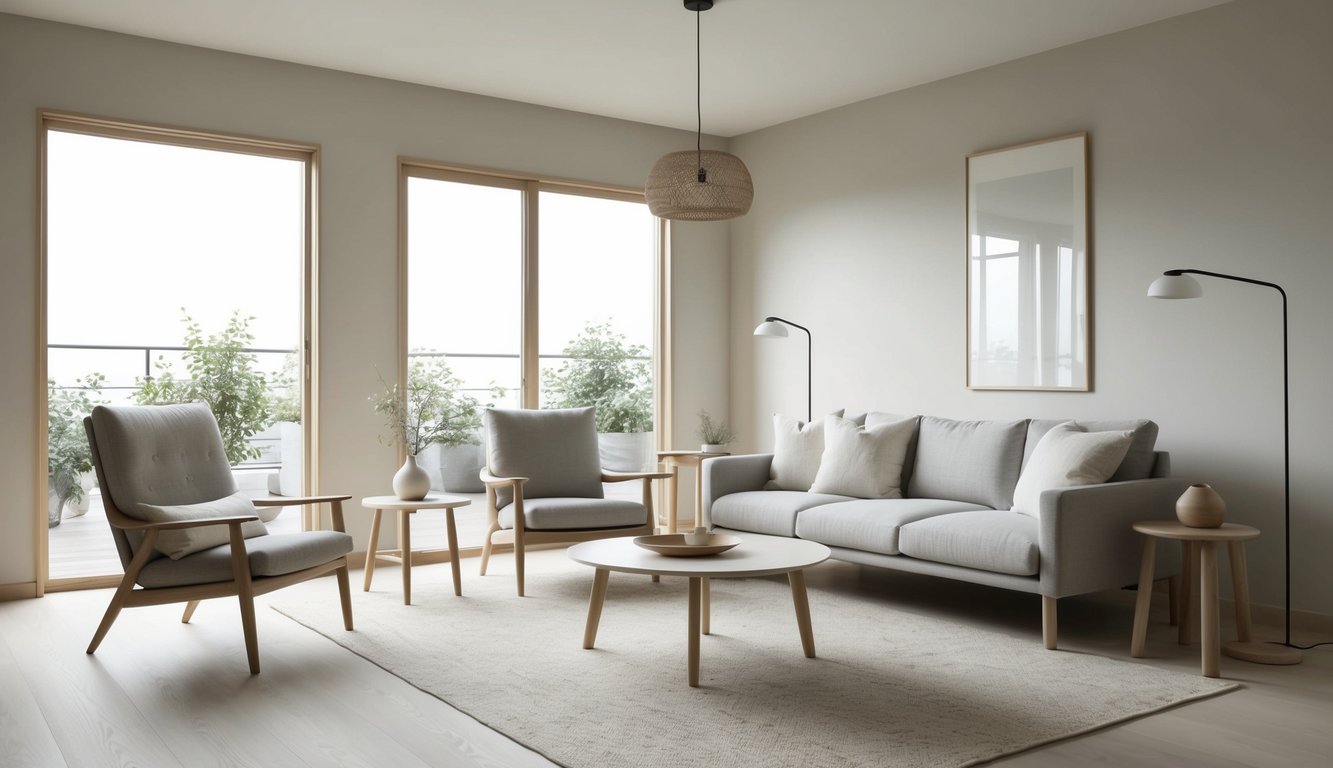Jan 13, 2025
•
Onton Team
Discover the elegance of Japandi interior design with our comprehensive guide. Explore its history, key elements, and tips for creating a serene space.
Japandi interior design blends Japanese and Scandinavian aesthetics to create harmonious, minimalist spaces. This fusion style emphasizes simplicity, natural materials, and a connection to nature.
Japandi interiors feature clean lines, muted color palettes, and carefully curated furnishings that balance form and function.
When you step into a Japandi-inspired room, you'll notice a sense of calm and tranquility. Neutral tones like warm whites, soft grays, and earthy browns dominate the color scheme.
Natural wood elements, from furniture to flooring, add warmth and texture. Greenery plays a key role, with carefully placed plants bringing life and freshness to the space.
Japandi design embraces the concept of "less is more." You'll find thoughtfully arranged furniture with sleek profiles and minimal ornamentation.
Accessories are sparse but meaningful, often incorporating handcrafted pieces that showcase the beauty of imperfection. The result is a living space that feels both cozy and sophisticated, inviting you to relax and unwind.
Key Takeaways
Japandi combines Japanese and Scandinavian design for a minimalist, nature-inspired aesthetic
Natural materials, muted colors, and clean lines are essential elements of Japandi interiors
Japandi spaces promote tranquility through thoughtful furniture placement and curated accessories
What Is Japandi Interior Design?
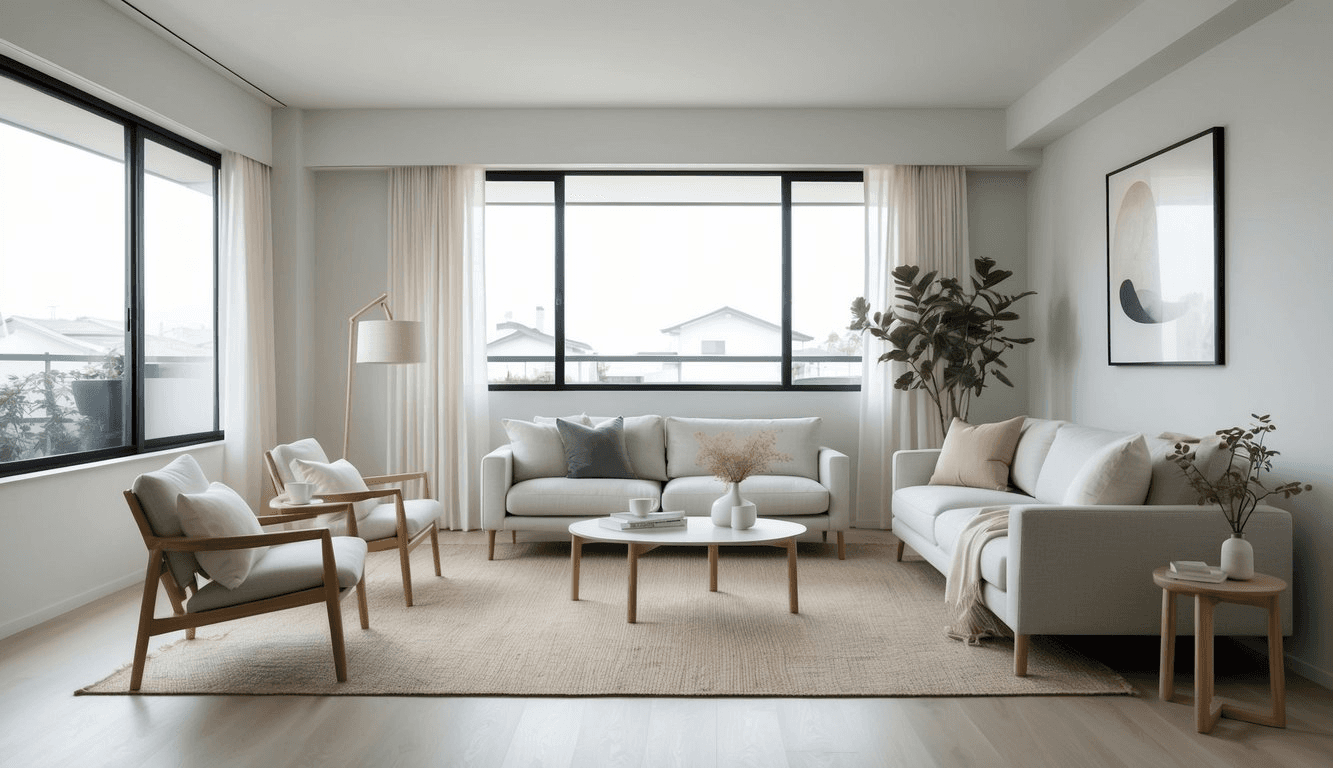
Japandi interior design blends Japanese and Scandinavian aesthetics to create a harmonious, minimalist style. You'll find a fusion of clean lines, natural materials, and neutral color palettes in Japandi spaces.
This design approach emphasizes simplicity and functionality. You'll notice a focus on high-quality, sustainable elements that bring nature indoors. Wood, stone, and natural fabrics are common materials used in Japandi interiors.
Colors in Japandi design tend to be muted and earthy. Think soft whites, warm grays, and gentle browns. These neutral tones create a calm, serene atmosphere in your home.
Japandi style embraces the concept of "less is more." You'll see uncluttered spaces with carefully curated furniture and decor pieces. Each item serves a purpose and contributes to the overall aesthetic.
Lighting plays a crucial role in Japandi interiors. You'll want to maximize natural light wherever possible.
Supplement with simple, elegant light fixtures to create a warm and inviting ambiance.
In Japandi design, you'll find a balance between comfort and minimalism. Cozy textiles and organic shapes soften the clean lines typical of Scandinavian design. This creates inviting spaces that are both functional and beautiful.
History And Origins Of Japandi Design
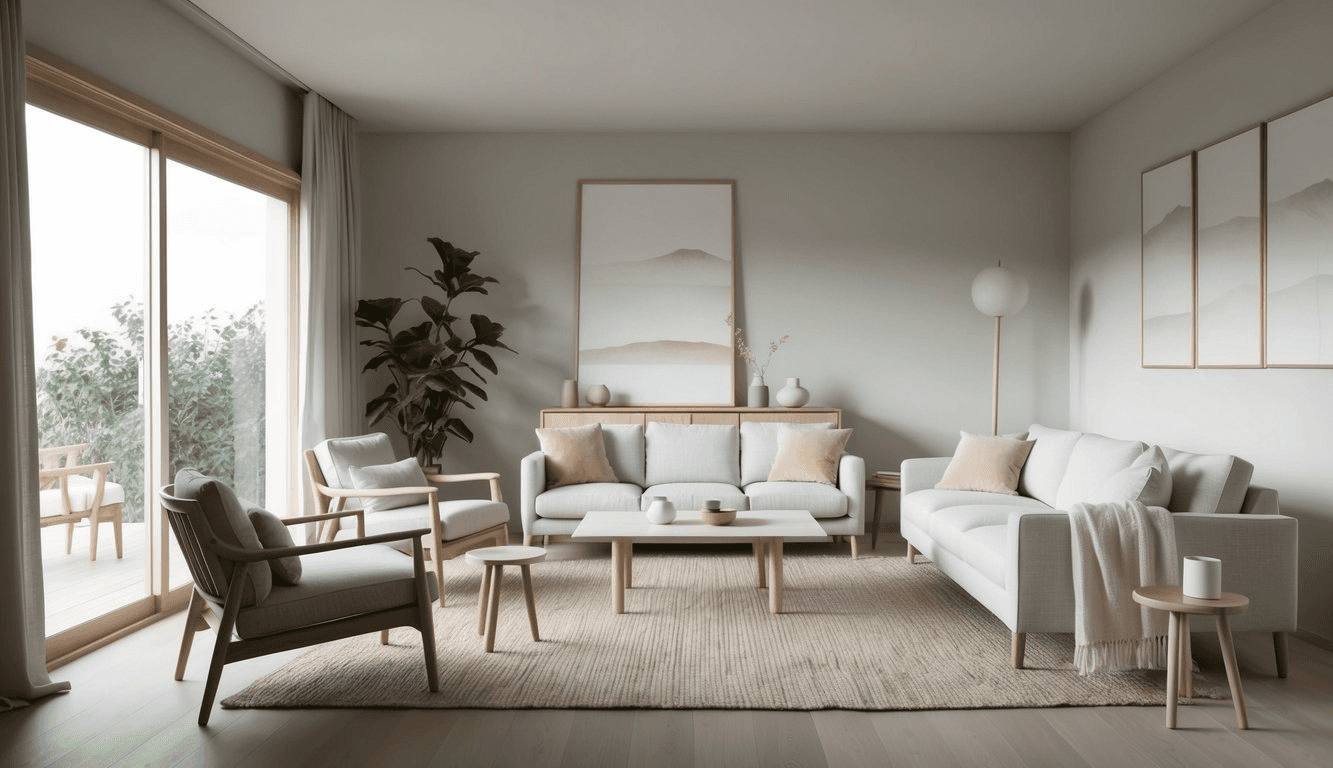
Japandi design emerged as a fusion of Japanese and Scandinavian aesthetics in the early 2010s. You'll find its roots in the shared appreciation for simplicity, functionality, and natural elements that both cultures embrace.
Japanese minimalism, with its focus on wabi-sabi principles, aligns seamlessly with Scandinavian design's emphasis on clean lines and practicality. This connection dates back to the mid-20th century when Danish designers drew inspiration from Japanese interiors.
The term "Japandi" itself gained popularity around 2016. It quickly caught on as designers and homeowners recognized the harmony between these two distinct yet complementary styles.
In Japanese interiors, you'll notice a focus on balance, tranquility, and the beauty of imperfection. Scandinavian design contributes its love for light, warmth, and cozy textures.
Japandi combines these elements to create spaces that are both serene and inviting. It balances the rustic charm of Nordic hygge with the refined elegance of Japanese aesthetics.
As sustainability became a growing concern, Japandi's emphasis on natural materials and craftsmanship resonated with eco-conscious consumers. This alignment with modern values has contributed to its rising popularity in recent years.
Japandi Influence On Interior Design
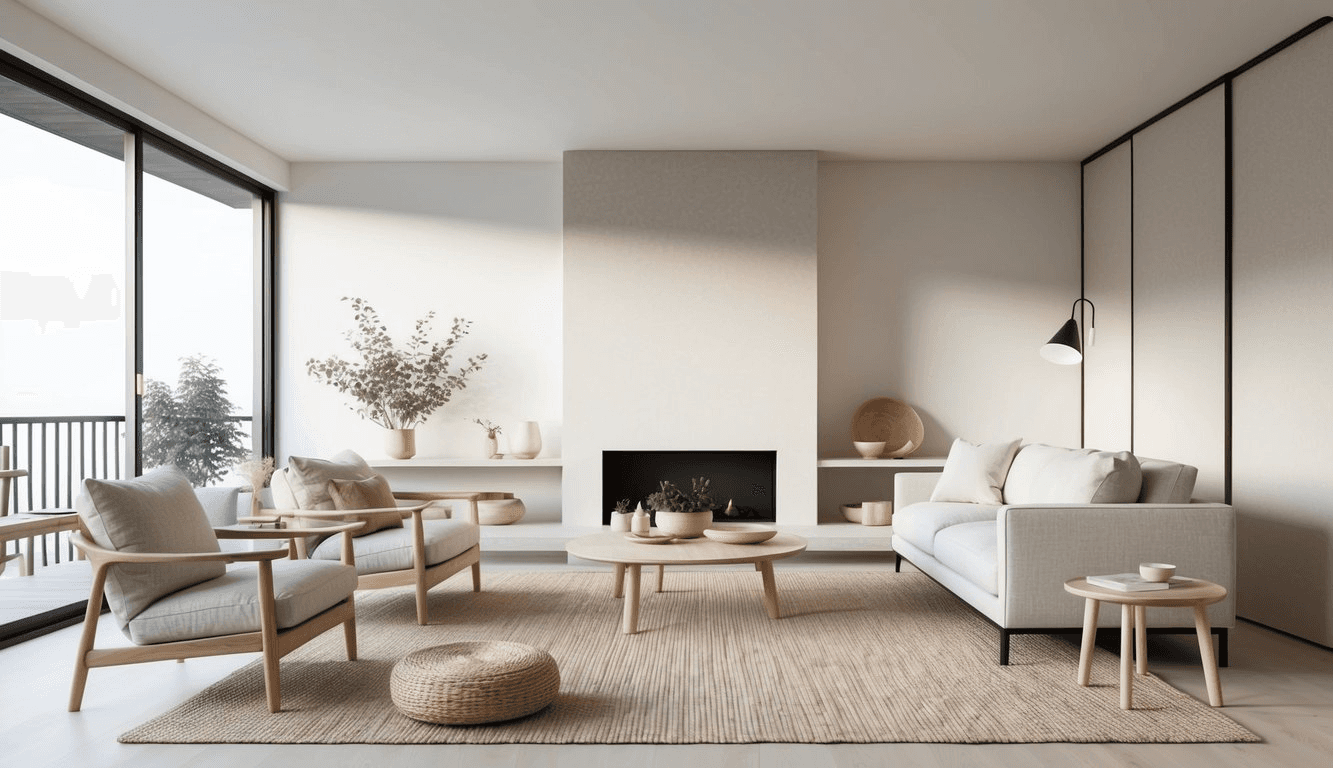
Japandi style has made a significant impact on modern interior design. This fusion of Japanese and Scandinavian aesthetics creates spaces that are both minimalist and warm.
In Japandi interiors, you'll find a focus on natural materials like wood, stone, and bamboo. These elements bring a sense of nature indoors, aligning with both Japanese and Scandinavian design principles.
Color palettes in Japandi spaces tend to be neutral, with occasional pops of muted colors. Think soft whites, warm grays, and earthy tones. This creates a calming atmosphere in your home.
Functionality is key in Japandi design. Every piece of furniture or decor serves a purpose, eliminating clutter and promoting a sense of tranquility.
Key elements of Japandi interior design:
Clean lines and simple shapes
Natural textures and materials
Minimalist decor
Neutral color palette
Functional, multi-purpose furniture
Incorporating Japandi elements can help you create a serene, balanced living space. By blending the best of both Japanese and Scandinavian design traditions, you can achieve a look that is both timeless and contemporary.
Key Elements Of Japandi Interior Design
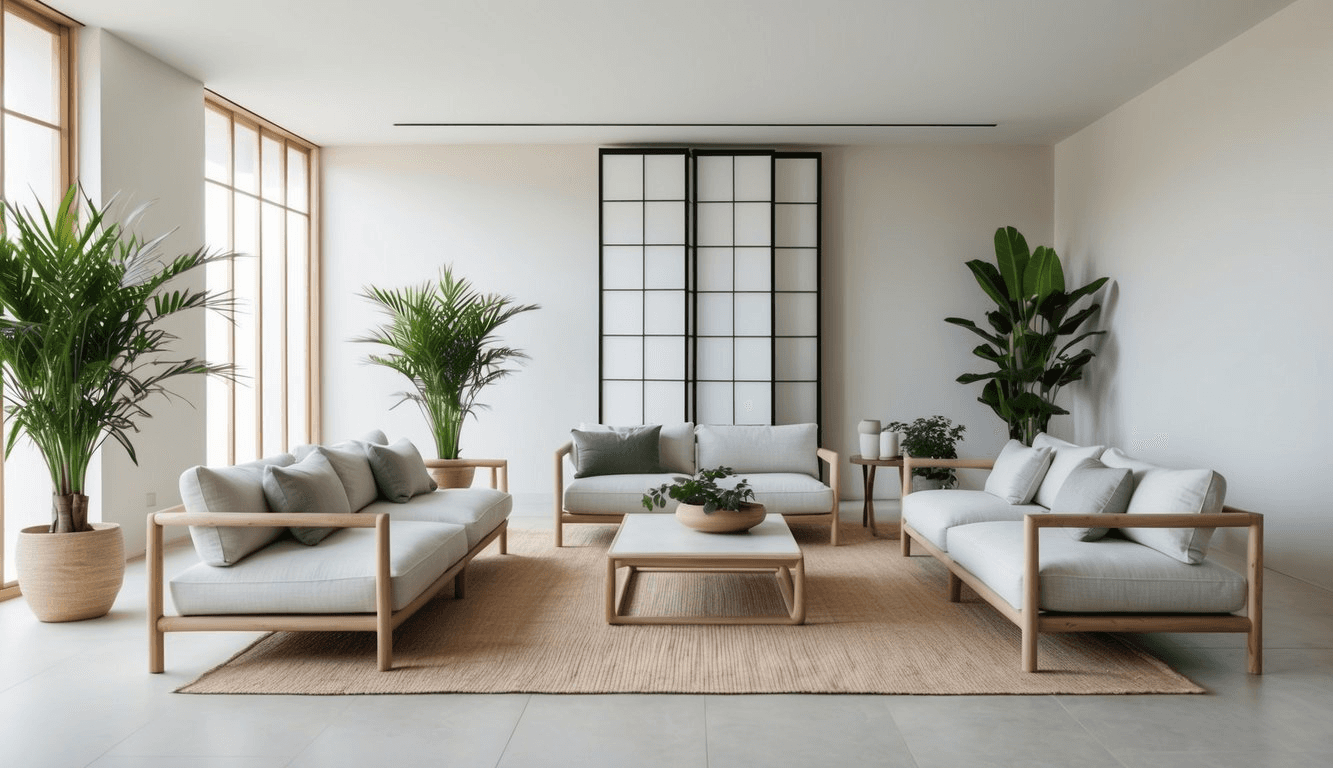
Japandi interior design blends Japanese and Scandinavian aesthetics to create serene, functional spaces. This style emphasizes simplicity, natural elements, and a harmonious balance between form and function.
Mindful Minimalism
Japandi design embraces a clutter-free environment. You'll find clean lines and uncluttered spaces that promote a sense of calm.
Decluttering is essential, focusing on quality over quantity. Choose furniture with simple, elegant forms.
Opt for pieces that serve a purpose and avoid unnecessary decorative items. This minimalist approach creates a peaceful atmosphere and allows each element to shine.
Incorporate negative space to give your rooms a sense of openness. This "breathing room" between objects helps reduce visual noise and enhances the overall aesthetic.
Natural Material Harmony
Japandi interiors celebrate raw materials. Wood is a cornerstone of this style, bringing warmth and texture to your space. Incorporate wooden furniture with clean lines and smooth finishes.
Bamboo, stone, and paper are also common elements. These materials add depth and interest while maintaining a connection to nature.
Mix textures thoughtfully to create visual interest without overwhelming the senses. Soft textiles like linen or wool can complement harder surfaces, adding comfort and coziness.
Neutral Color Philosophy
A muted color palette is key to Japandi design. Neutral tones create a calm, cohesive backdrop for your space. Think soft whites, warm grays, and earthy beiges.
Accent these neutral bases with subtle pops of color inspired by nature. Soft greens, muted blues, or warm terracottas can add depth without disrupting the overall serenity.
Your color scheme should flow naturally throughout your home. This continuity helps create a sense of harmony and balance.
Consider using a mix of warm wood tones, cool stone grays, and soft, natural whites.
Functional Aesthetics
In Japandi design, beauty and practicality go hand in hand. Every item in your space should serve a purpose while contributing to the overall aesthetic.
Choose furniture with clean lines and simple shapes. Look for pieces that offer storage solutions to maintain a clutter-free environment.
For example, a sleek coffee table with hidden compartments, a minimalist desk with integrated cable management, or a platform bed with built-in drawers.
Prioritize comfort without sacrificing style. Opt for ergonomic designs that support your daily activities while maintaining the understated elegance of Japandi interiors.
Artisanal Craftsmanship
Japandi design values high-quality, handcrafted items. Incorporate pieces that showcase skilled workmanship and attention to detail.
This focus on craftsmanship adds character and depth to your space. Look for hand-thrown ceramics, carefully woven textiles, and artisanal wooden furniture.
These unique items bring a sense of individuality to your home. They also reflect the Japandi philosophy of investing in fewer, better-quality pieces that will stand the test of time.
Nature Integration
Bringing the outdoors in is a crucial aspect of Japandi design. Natural light plays a significant role, so maximize your windows and use sheer curtains to allow sunlight to filter through.
Incorporate plants to add life and freshness to your space. Choose low-maintenance varieties that thrive indoors, such as snake plants, fiddle leaf figs, and pothos.
Natural elements like stones, branches, or dried flowers can serve as simple, organic decorative touches.
These elements help maintain a connection to the natural world and enhance the calming atmosphere of your home.
Comfort-Harmony Balance
Japandi interiors strike a delicate balance between comfort and visual harmony. Soft textures play a crucial role in creating inviting spaces.
Incorporate cozy throws, plush rugs, and comfortable seating to add warmth to the minimalist design.
Choose furniture with organic shapes that complement the clean lines of your space. Rounded edges and gentle curves can soften the overall look and create a more welcoming atmosphere.
Remember to maintain a sense of openness and flow in your layout. Arrange furniture to allow for easy movement and create functional zones within each room.
This thoughtful approach ensures your space is both beautiful and livable.
Substyles Of Japandi Interior Design
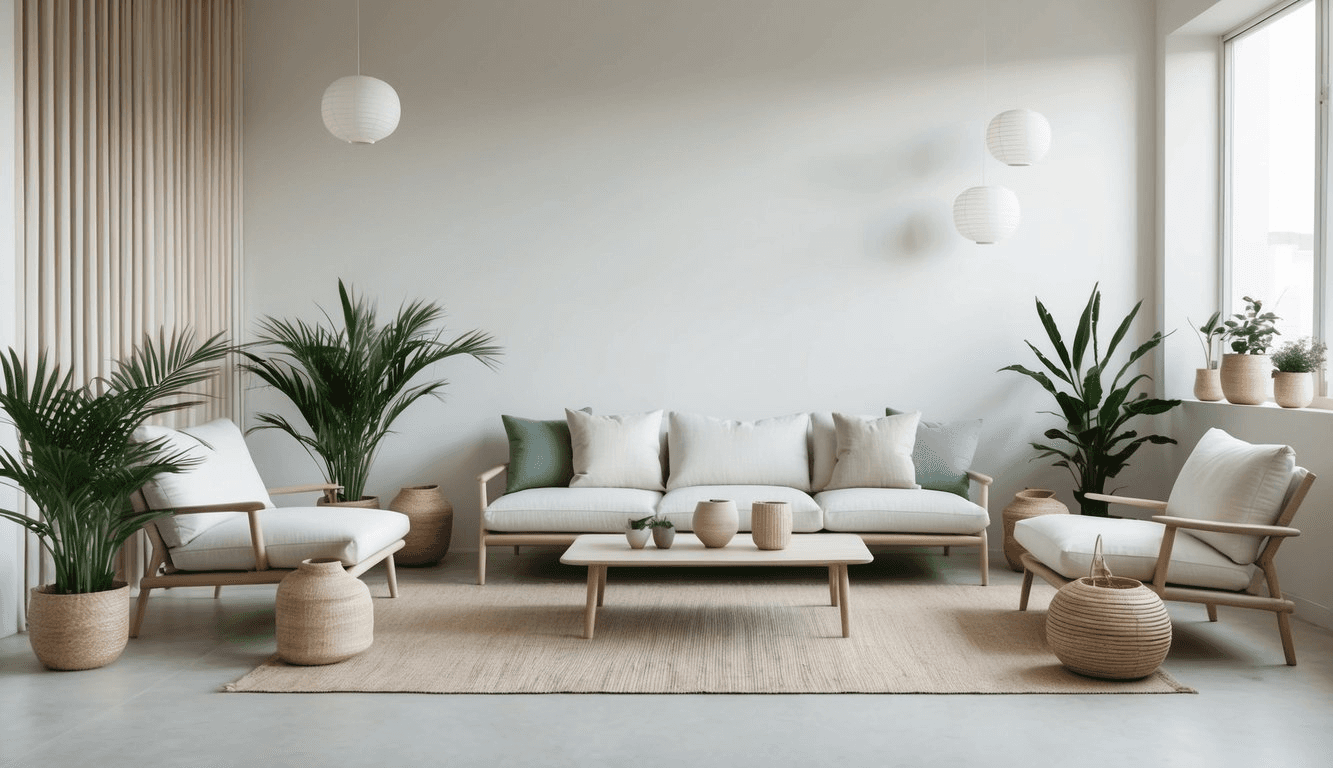
Japandi design offers versatility through various substyles, each putting a unique spin on the core aesthetic. These adaptations allow you to tailor the look to your preferences and living space.
Modern Japandi
Modern Japandi embraces sleek lines and contemporary elements. You'll find minimalist furniture with clean silhouettes and innovative materials.
Metallic accents in brushed finishes add a touch of sophistication. Neutral color palettes dominate, but pops of muted colors can appear in artwork or accessories.
Lighting fixtures often feature geometric shapes or abstract designs. Smart home technology integrates seamlessly, hidden behind simple facades.
Storage solutions are clever and unobtrusive, maintaining the clean aesthetic. Large windows let in ample natural light, enhancing the spacious feel. Flooring tends towards light-colored hardwoods or large-format tiles.
Rustic Japandi
Rustic Japandi incorporates more organic textures and weathered elements. You'll see rough-hewn wooden beams, hand-crafted ceramics, and natural stone surfaces.
Wabi-sabi principles shine through in imperfect finishes and patinas. Colors lean towards earthy tones - warm browns, soft greens, and clay reds.
Textiles feature nubby textures in linen or wool. Handwoven baskets and woven wall hangings add visual interest.
Furniture pieces often showcase live-edge wood or reclaimed materials. Lighting might include paper lanterns or fixtures with natural materials like bamboo.
Indoor plants play a significant role, bringing nature indoors.
Coastal Japandi
Coastal Japandi blends seaside elements with Japandi's calm simplicity. Light, airy spaces dominate with a color palette inspired by sand, sea, and sky.
You'll find soft blues, warm beiges, and crisp whites. Natural materials like driftwood, seagrass, and linen create a relaxed atmosphere.
Furniture tends to be low-profile with curved edges reminiscent of ocean waves. Artwork often features abstract seascapes or coastal photography.
Light fixtures might incorporate elements like capiz shells or frosted glass. Window treatments are minimal, allowing ocean views to take center stage.
Accessories include items like smooth river stones or glass fishing floats.
Zen Japandi
Zen Japandi emphasizes tranquility and mindfulness in design. You'll create spaces that feel like sanctuaries from the outside world.
Neutral colors dominate, with occasional pops of soothing green or calming blue. Furniture is low to the ground, encouraging a sense of grounding.
Natural materials like bamboo and paper feature prominently. You might incorporate a small indoor rock garden or a tabletop water feature.
Lighting is soft and diffused, often using paper lanterns or candles. Artwork is minimal, perhaps a single calligraphy scroll or abstract nature print.
Storage is hidden away to maintain a clutter-free environment.
Minimalist Japandi
Minimalist Japandi takes the "less is more" approach to its extreme. You'll create spaces that are pared down to the absolute essentials.
Color palettes are typically monochromatic, focusing on whites, grays, and blacks. Furniture is highly functional with clean lines and no unnecessary ornamentation.
Storage is built-in and seamless, maintaining uncluttered surfaces. Textures become important to add visual interest - think smooth concrete against rough linen.
Lighting is architectural, often recessed or integrated into the structure. Art is sparse, perhaps a single striking piece in each room.
The focus is on negative space and the interplay of light and shadow.
Room By Room Japandi Design Ideas
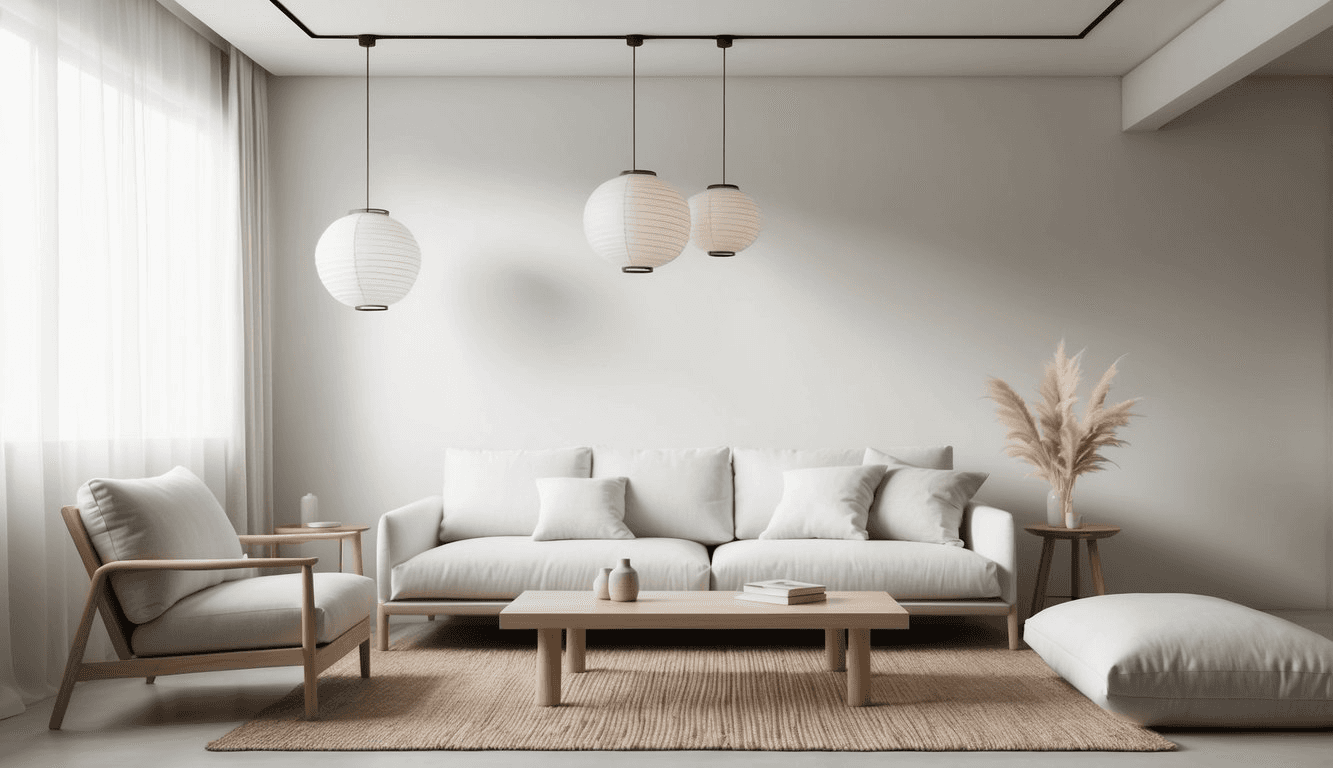
Japandi design seamlessly blends Japanese minimalism with Scandinavian comfort across various living spaces. Each room offers unique opportunities to incorporate natural elements, clean lines, and a serene color palette.
Living Room
Create a calming Japandi living room with a neutral color scheme. Choose a low-profile sofa in light gray or beige, paired with wooden accent chairs.
Add texture with woven floor cushions and a natural fiber rug.
Incorporate a low wooden coffee table and minimalist shelving units. Display a few carefully chosen decorative items, like ceramic vases or stone sculptures.
Bring in greenery with potted plants in simple ceramic planters. Opt for species like snake plants or bamboo palms that thrive indoors and complement the Japandi aesthetic.
Use sheer curtains to allow natural light while maintaining privacy. Install warm, dimmable lighting fixtures to create a cozy ambiance in the evenings.
Kitchen
Design a functional Japandi kitchen with clean lines and natural materials. Choose light wood cabinetry with minimal hardware for a sleek look. Pair with countertops in muted tones like light gray or off-white.
Incorporate open shelving to display carefully curated dishware and cooking essentials. Select pottery and utensils in earthy tones and natural materials.
Install a large farmhouse sink and simple, modern faucet. Opt for energy-efficient appliances in stainless steel or matte black finishes.
Add warmth with wooden bar stools at the kitchen island. Place a few potted herbs on the countertop for a touch of greenery and practicality.
Bedroom
Create a serene Japandi bedroom focused on rest and relaxation. Choose a low platform bed frame in light wood or upholstered in a neutral fabric. Dress the bed with high-quality linen bedding in soft, muted colors.
Incorporate built-in storage or a minimalist dresser to keep clutter at bay. Add a simple bedside table with a ceramic table lamp for soft lighting.
Hang sheer curtains or install wooden blinds for light control. Place a woven area rug beside the bed for added comfort and texture.
Introduce calming elements like a small indoor fountain or a bonsai tree. Keep wall decor minimal, with perhaps a single piece of nature-inspired artwork.
Bathroom
Design a spa-like Japandi bathroom that promotes relaxation. Choose a freestanding bathtub in a simple, organic shape. Install a rainfall showerhead for a luxurious shower experience.
Opt for a floating vanity in light wood with a stone or concrete countertop. Select minimalist fixtures in brushed nickel or matte black.
Use large-format tiles in neutral tones for floors and walls. Incorporate natural elements like a wooden bath mat or stone soap dishes.
Add warmth with bamboo towel ladders and woven storage baskets. Place a moisture-loving plant like a fern or orchid to bring life to the space.
Home Office
Create a productive Japandi home office that balances function and aesthetics. Choose a simple wooden desk with clean lines and minimal drawers. Pair with an ergonomic chair in a neutral upholstery.
Incorporate open shelving for books and supplies. Use woven baskets or boxes to keep smaller items organized and out of sight.
Add a comfortable reading nook with a low armchair and floor lamp. Place a small side table nearby for tea or coffee.
Bring in natural light with sheer window coverings. Use task lighting on the desk for focused work. Add a few potted plants to improve air quality and create a calming atmosphere.
Why Choose Japandi Design
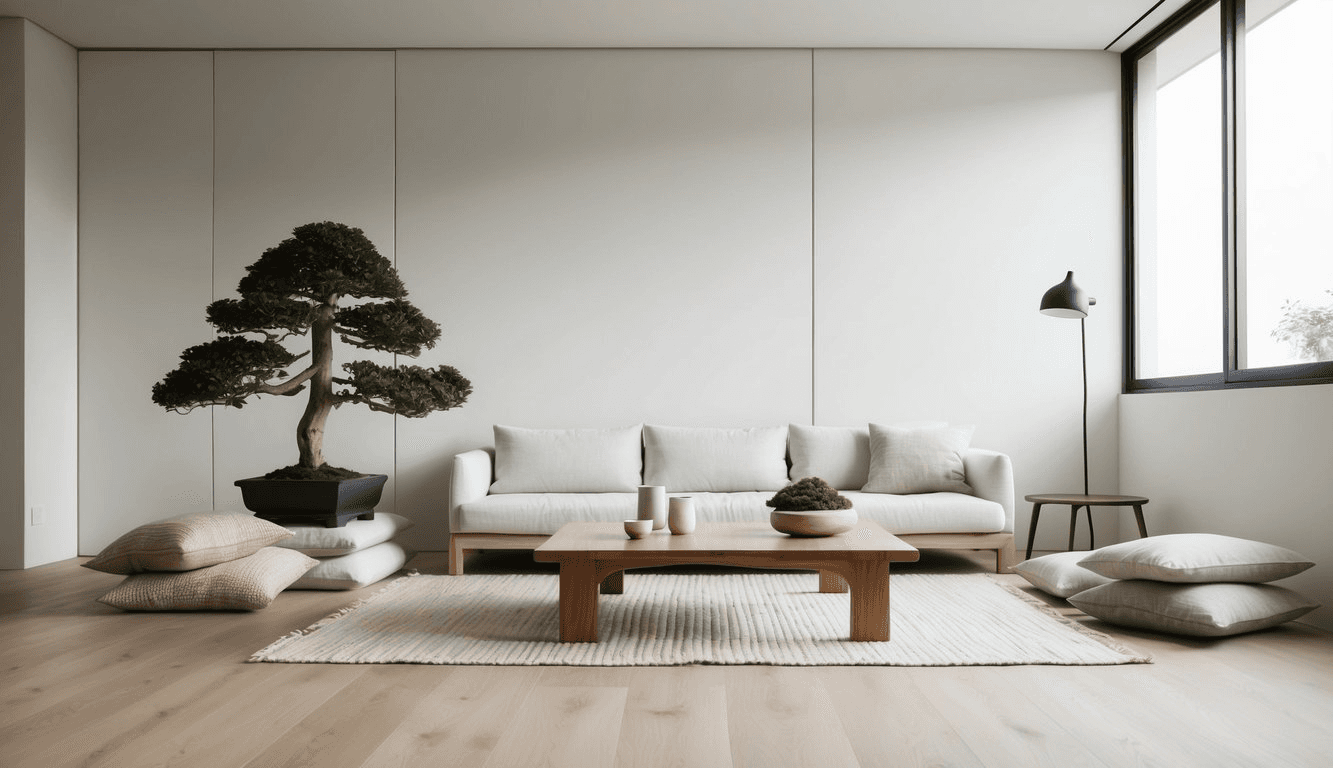
Japandi design offers a perfect blend of functionality and aesthetics for your home. This style combines the best of Japanese and Scandinavian design principles, creating spaces that are both beautiful and practical.
You'll find a sense of tranquility in Japandi interiors. The clean lines and uncluttered spaces promote a serene atmosphere, helping you relax and unwind after a busy day.
Sustainability is a key aspect of Japandi design. By choosing high-quality, durable materials and timeless pieces, you're investing in furniture and decor that will last for years to come.
The neutral color palette typical of Japandi style is easy on the eyes and creates a calm environment. You can add pops of color through carefully selected accessories or artwork for visual interest.
Japandi design emphasizes natural materials like wood, bamboo, and stone. These elements bring warmth and texture to your space while connecting you to nature.
You'll appreciate the balance between form and function in Japandi interiors. Every piece serves a purpose, reducing clutter and promoting a more organized lifestyle.
By choosing Japandi design, you're embracing a style that values craftsmanship and quality. Handmade items and artisanal touches add character and uniqueness to your home.
The minimalist approach of Japandi design can help you focus on what truly matters. By surrounding yourself with only essential and meaningful items, you create a space that reflects your values and priorities.

